Alaska Fish & Wildlife News
January 2024
Beans for the Birds
Bird Friendly Coffee and Alaska Songbirds
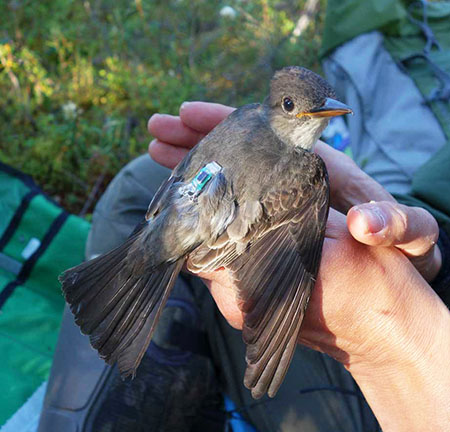
I love drinking coffee on weekend mornings, and, like many people, I also love birds. Drinking Bird Friendly coffee is a recent conservation action I’ve adopted to help Alaska songbirds.
North American songbirds are in trouble and need our help. Since 1970, bird numbers in North America have declined almost 30 percent. There are literally billions fewer songbirds than there used to be in our woods and wetlands. For some birds, such as Olive-sided flycatchers, who nest in Alaska and migrate through and spend their winters in coffee-growing regions of Central and South America, the declines have been far greater, almost 80 percent. Alaska researchers like Dr. Julie Hagelin have learned the problem is not with the flycatchers nesting in Alaska – that’s going well – it’s their time spent outside of the state during migration and winter. That’s how drinking “Bird Friendly” coffee can help these songbirds even when they’re not here.
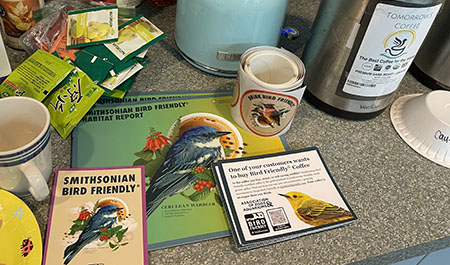
Habitat loss is the top reason for the decline of bird species over the last few decades. Much of that loss is due to agriculture, with 75 percent of the world’s coffee farmed in a way that decreases available habitat for birds. To help address this, The Smithsonian Migratory Bird Center offers a certification to coffee that is grown while preserving bird habitat in coffee growing regions. Instead of deforesting an area to make way for coffee trees, Bird Friendly coffee is shade-grown, with the coffee trees cultivated under the intact canopy of the forest. This maintains the biodiversity and habitat needed by both migratory bird species passing through and those spending their winter there. According to the Smithsonian, this certification is awarded to some 5,100 coffee farmers in 11 countries, with 34 million pounds of coffee grown each year that conserves bird habitat.
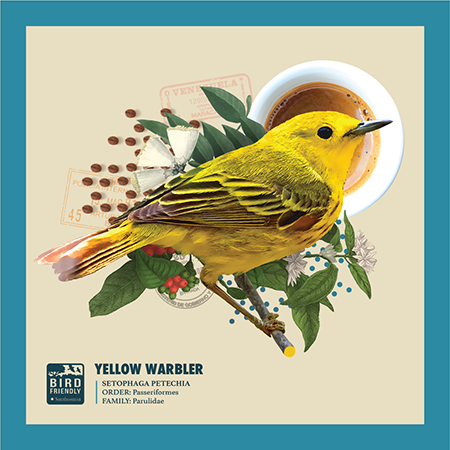
When I look for coffee now, I try to find Smithsonian certified shade-grown coffee. “Rainforest Alliance Certified” is another example, and like “Bird Friendly,” these agricultural products (which also include cocoa, tea, spices, fruit, flowers, nuts and vegetables) are grown in maintained bird habitat and without the pesticides that can reduce available prey for birds. Other labels might evoke sustainability or bird-friendliness, like “shade grown,” but may not be an actual regulated designation.
While I look for the Bird Friendly certification, it is usually not available in Alaska stores and needs to be ordered online. But by asking local roasters and coffee shops about bird friendly coffee, and starting conversations, perhaps it could be more accessible in the future as a recognized demand encourages businesses to seek it out. If you can’t swing the certified coffee beans, organic coffee is the next best option for birds. I’ve been drinking Bird Friendly coffee for a year now, and it’s good coffee. I’m willing to pay more, wait a little bit for my order to arrive, and spread the word about the certification if it means I can help North American songbirds, and especially Alaska’s Olive-sided Flycatcher.
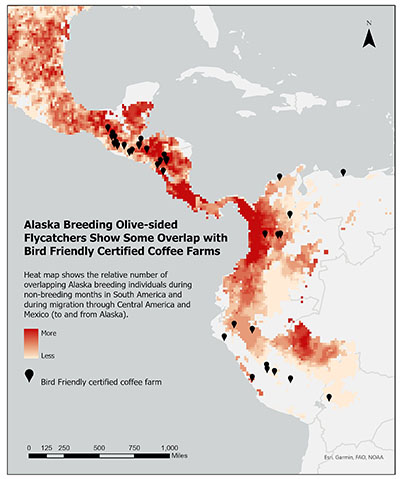
I hear and see this little gray-green bird in June every year and always listen for its trademark “quick, three beers!” call across the lake. In 2015, Dr. Hagelin also spent several buggy summers in Fairbanks wetlands, deploying GPS tags on these birds to study their migration route. One particular tagged bird left Fairbanks in October for fall migration and spent three months traveling across the Americas to a wintering site in Brazil. Hagelin used this tracking data to pinpoint hotspot locations where the Olive-sided flycatchers relied on re-fueling to continue their journey. This recent research demonstrated Alaska flycatchers passing through noted Bird Friendly coffee farms, with many most likely seeking out the preserved habitat along the way and increasing their chances of making it back to Alaska for the following summer.
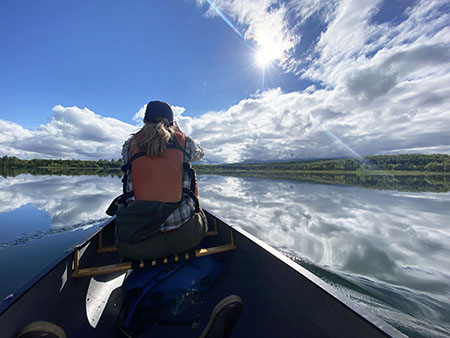
I’ll be looking for these tree-topping birds next June, back from one of the longest songbird migrations in the world, and with my thermos of Bird Friendly coffee in the canoe!
Check out 3billionbirds.org for more conservation actions that can help North American birds.
Subscribe to be notified about new issues
Receive a monthly notice about new issues and articles.
